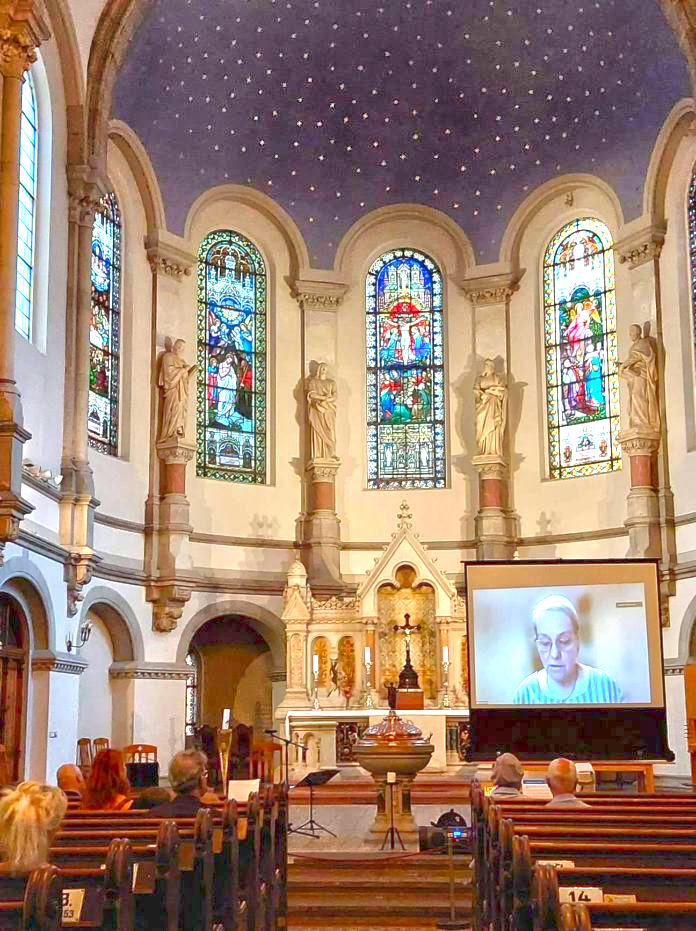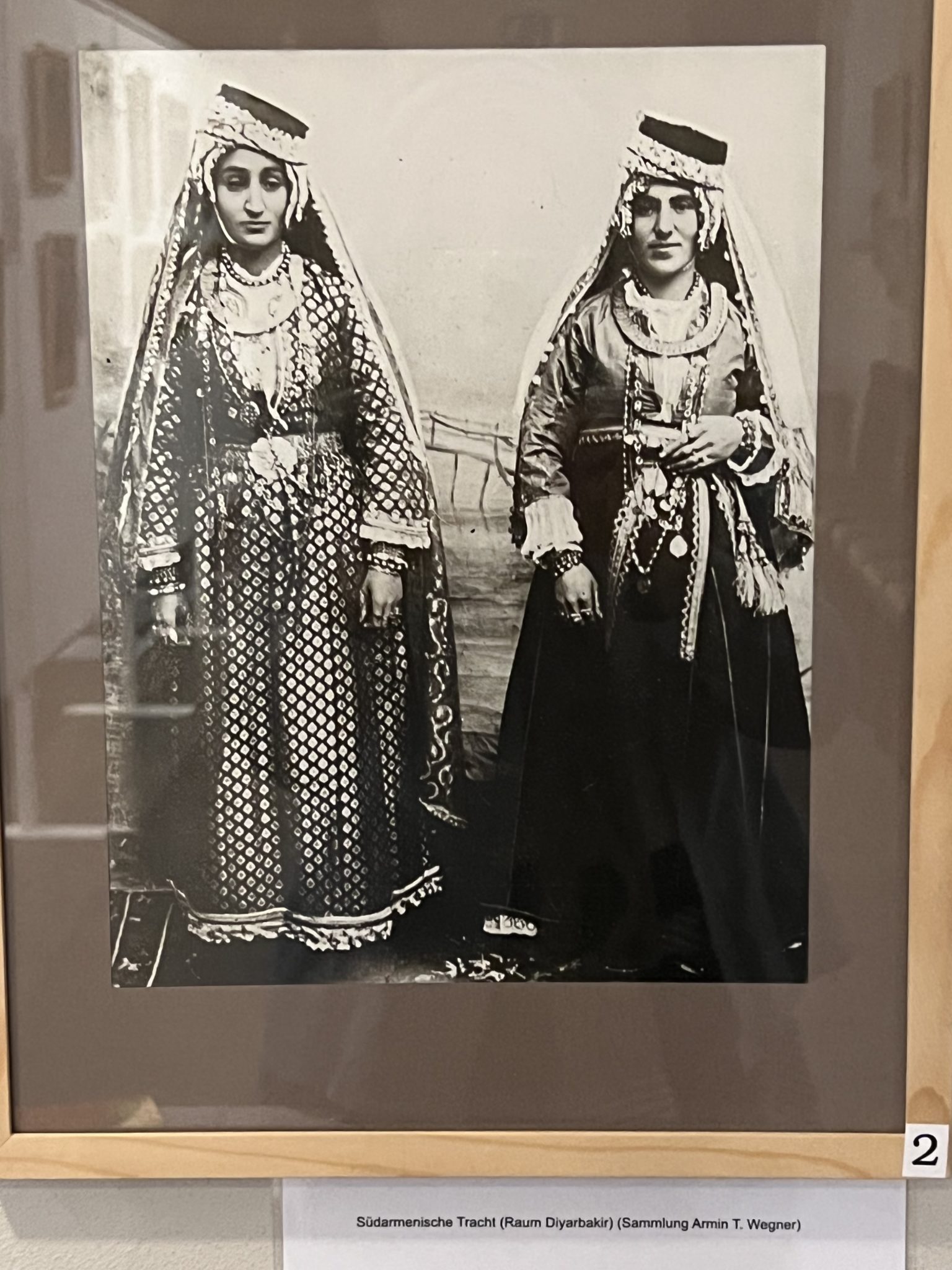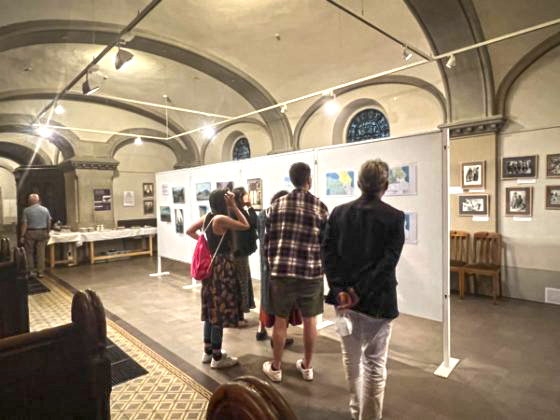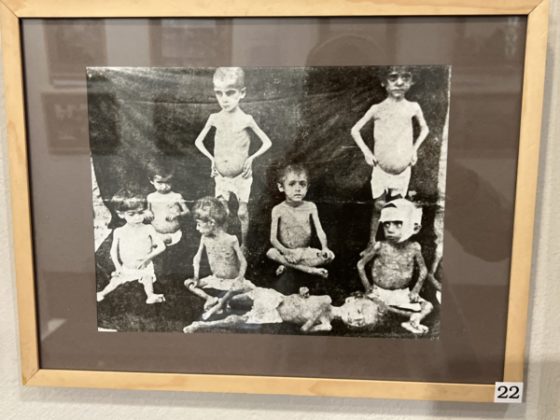
Tessa Hofmann introduces exhibition (Ani Galustian photo)
Dresden Hosts Photo Exhibition on Genocide
by Muriel Mirak-Weissbach
DRESDEN, June 23, 2022 — A picture is worth a thousand words. The saying has become a cliché, and for good reason: it holds true. Nothing could prove this more convincingly than an exhibition that opened on June 16 in Dresden, Germany. Organized by the “Haytun” Armenian Cultural Association in Dresden together with the Armenian Information and Documentation Center (IZDA, Berlin), the vernissage took place in the Martin Luther Church.
Introduced by Prof. Tessa Hofmann of the IZDA, who spoke via video link, it is not a new collection. In fact, it was first presented to the public in 1999, and since then has been displayed in several venues both in Germany and abroad, among them, the German Sinti and Roma Documentation Center in Heidelberg, the Progressive Synagogue in the London districts of Harrow and Wembley, the Peace Church in Bremen and the St. Catherine’s Church in Frankfurt, the Leer town hall in East Friesland and Anti-War Museum in Berlin-Wedding. This new version appearing in Dresden represents an important contribution to the continuing campaign to educate the German public, especially its younger generation, on the history of the genocide against the Armenians and other Christian minorities in the Ottoman Empire.

Southern Armenian traditional dress (Diyabakir region), Armin T. Wegner collection (Gülsen Aytan photo)
The exhibition is entitled, “Deportation, Persecution, Annihilation.” Father Eckehard Möller of the Dresden-Neustadt parish greeted guests and told them how he had first become acquainted with the Armenian question and the genocide. It was during a visit to Jerusalem that he received a leaflet from someone on the street. The leaflet showed a map of the genocide, with deportations routes and sites of massacres. It was a map that would lead him to learn about the events of over a century ago. The chairman of the Haytun cultural group, founded just a year ago, said a few words about the open wound which cannot heal, due to continued denial of the genocide, and expressed the hope that both communities here in Germany might find the way to work through the past and approach reconciliation, without political pressure from the current Turkish government.
World War I and the Camera
The items on display come largely from a collection of the Armenian Information and Documentation Center, which covers the genocide as well as Armenian life and culture in the period prior to the catastrophe. Hofmann summarized the historical process leading to the genocide perpetrated by the Young Turk regime, in the course of the World War and thereafter, a process that saw the collapse of the Ottoman as well as the Russian and Hapsburg empires. Clearly, she explained, it was impossible to record on film the complete unfolding of the genocide through slave labor, massacres and deportations, for many reasons; “to be sure the First World War marked the birth of photographic war reportage and the use of photos for propaganda purposes…. But the medium remained limited,” as cameras at that time were extremely costly, not easily transportable items. “Above all, those committing genocide certainly don’t want to be photographed while committing mass murder.” Legal prohibition by the Turkish authorities as well as fear of epidemic disease such as typhus prevented photographers from documenting the atrocities.
One exception was the work of German medical orderly Dr. Armin T. Wegner, who managed to take pictures of concentration camps near Aleppo, in the company of Swiss missionary nurse Beatrice Rohner; another was Danish missionary Karen Jeppe, who photographed the remains of starved victims in Urfa.

Visiting the exhibition (Gülsen Aytan photo)
The exhibition documents the massacres under the despotic Sultan Abdul Hamid in 1894-96 as well as in 1909, to the capture of Smyrna, whose Christian quarter was set afire in 1922 by the Kemalist cavalry.
The photographic material displayed serves to illustrate the phases as well as the methods deployed by the perpetrators, from Interior and War ministers Talaat and Enver, through their party leaders and down to the criminal gangs known as çeteler. Not only photos but also newspaper clippings, as well as illustrations and graphics from the European and American press of the period bear witness to events. Hofmann noted that this material perhaps says more about the “image of the Orient” that the illustrators had than about the actual criminal acts, due to logistical and political measures taken by the perpetrators. For example, Ahmed Çemal, then commander of the 4th Ottoman army in Syria, banned photos in 1915 for the entire district, which was the location of the mass deportations, death marches and massacres in the desert. Swiss, German and Italian engineers working on the Baghdad railway were forced to hand over any and all photographic or film material they had. Only when British forces took Syria in 1917 did this policy change, and persons engaged with the American Committee for Armenian and Syrian Relief (later called Near East Relief) were able to document the condition of Armenian and Syrian Christian survivors. Thus, it is largely the pictures assembled in the Wegner collection and those of Near East Relief, in the Library of Congress since 1987, that represent the bulk of documentary materials.
The Multiple Images of Genocide
The exhibition in Dresden includes 51 photographic documents on the persecution of the Armenians (1894-1922), and a smaller group of 14 color photos titled, “At the Foot of Dormant Volcanoes: Armenia’s Landscapes and Culture.”
Hofmann illustrated a sampling of the exhibits in a Powerpoint presentation, telling the stories behind them: the role of workers on the Baghdad railway project, the plight of children, the death marches and later refugee flows out of Cilicia, up through the conflagration of Smyrna in September 1922. A few of the images are familiar, as they have been reproduced in standard works on the genocide. Yet, even familiarity does not, cannot lessen the impact. Among the many pictures encountered for the first time, the most excruciating to witness (in the view of this writer) are those of the children: emaciated, naked, traumatized, dying or dead, and no one seems to notice.

Starving children (Gülsen Aytan photo)
Educating the Public
The importance of such exhibitions in Germany cannot be overstated. To people living in places where there are genocide museums, where universities that have genocide studies centers are not a rarity, where the Ottoman genocide appears in text books for schools, this may come as a surprise. But in Germany, the situation is different. For example: although a resolution on the genocide passed by the Bundestag (Parliament) in 2016 foresaw inclusion of the subject in secondary education and textbooks, little has been accomplished. It is the federal states that regulate curricula. Just a month ago in Cologne, city authorities removed a sculpture commemorating the victims of the genocide from a public place. The civil society association “Remember Genocide” had placed it there during an April 24 remembrance event. The city authorities of Cologne, a sister city of Istanbul, were intervening against the monument for the fourth time since 2018, and were acting also “in consideration of the large number” of citizens of Turkish background, according to press accounts.
The collection now on display in Dresden, will be open to the public until June 30, and it may be curated there and elsewhere on loan. On June 23 a reading was held of texts by Armenian authors who were murdered in the course of the genocide. Those who cannot visit the exhibition may see the items displayed online at http://www.aga-online.org/genocide/armenians.php?locale=de.
The exhibits are also available in a book edited by Gerayer Koutcharian and Tessa Hofmann, Verfolgung, Vertreibung, Vernichtung. Bilder und Texte zum Genozid an den Armeniern 1915/1916, Donat-Verlag 2017.